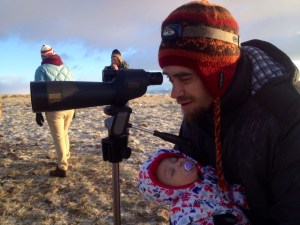Watching birds in cool places is the perfect way to get outside for mini-adventures with tots
I bet you never thought birding was hard-core. I didn’t really, either. But then we added a baby to the mix, and Montana decided to sprinkle in some of its famous fickle weather to make our bird-watching missions more interesting.
I’ve always liked birds. During college in San Diego, I chose to study the nesting behavior of terns down at the estuary near Ocean Beach as my senior project. It wasn’t much of a hardship to bike to the beach and sit around watching birds dive and swoop against a bluebird sky. Then I moved to Montana, and lost track of my birding motivation when the shorebirds and waves were replaced with hard-to-spot, tree-dwelling passerines and cold air.
Enter Rob. He loves counting the songbirds off our back porch, or carting out his scope to find raptors along rivers. I started to excited about feathered flocks again, especially during the spring migration when birds seem to appear out of thin air after their tropical adventures to the south.

During our sailing trip last year, both Rob and I met a whole new host of birds, using them to gauge our distance from land during passages, and as a way to become familiar with each new island. We even had a pet Christmas shearwater aboard for a few days somewhere south of the Equator and west of the Galapagos–it got confused during a squall, and hunkered down in the cockpit of Llyr to recover.
Now, birding seems like the perfect way to get outside for mini-adventures with an 8-month-old … especially when the baby in question is fortuitously named “Talon.” First stop: Freezeout Lake along the Rocky Mountain Front, home of a massive migration of waterfowl each March. We braved 50 mph gusts of wind and ominous (but gorgeous) skies to watch 8,000 snow geese rise off the lake. Talon slept through it.

Next stop in April: Bannack Ghost Town to camp and watch Greater sage-grouse strut in search of mates. It dropped to 20 degrees F and snowed covered our little tent before we could even finish dinner. After bundling up in parkas, hats, gloves, insulated boots, and downing thermos of coffee, we trundled to the lek before dawn and watched the male grouse dance up a storm for the uninterested hens. Talon slept through it all.
In California, I introduced Talon to the terns that I used to study. We pointed out pelicans and plovers, sandpipers and seagulls, all the while dodging the relentless rollerbladers who refuse to yield. While the weather always cooperates in San Diego, the cutthroat pedestrians on the boardwalk are scarier than any gales I’ve encountered. Talon definitely didn’t fall asleep on the boardwalk. But he certainly wasn’t interested in some old birds when dudes were blading by in chaps (and nothing else).

Back on the homefront, we heard that a Great-horned owl had set up a nest nearby, hanging out with her three fledglings in a big cottonwood tree. Making sure it was before Talon’s bedtime, we biked him down to the park and hiked along the creek to the nest. The mama owl landed in a pine directly overhead, and proceeded to eat an entire trout in front of us while her babies watched. Talon, of course, fell asleep before the scope was set up.
Last weekend, we joined an Audubon field trip to the Montana Waterfowl Foundation in the Mission Valley, which rears and then releases several types of native birds to increase their dwindling numbers in the wild. The birds that finally kept Talon awake? A pair of prehistoric-looking sandhill cranes that squawked loud enough to keep him wide-eyed.
Next up: a five-day rafting trip on the John Day River in Oregon, which is sure to add plenty of new bird (and fish!) species to Talon’s already-impressive Life List.




